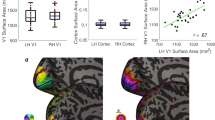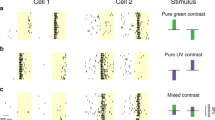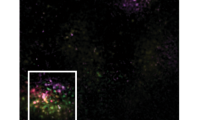Abstract
The primate retina contains three classes of cones, the L, M and S cones, which respond preferentially to long-, middle- and short-wavelength visible light, respectively. Colour appearance results from neural processing of these cone signals within the retina and the brain. Perceptual experiments have identified three types of neural pathways that represent colour: a red–green pathway that signals differences between L- and M-cone responses; a blue–yellow pathway that signals differences between S-cone responses and a sum of L- and M-cone responses; and a luminance pathway that signals a sum of L- and M-cone responses1,2,3. It might be expected that there are neurons in the primary visual cortex with response properties that resemble these three perceptual pathways, but attempts to find them have led to inconsistent results4,5,6,7. We have therefore used functional magnetic resonance imaging (fMRI) to examine responses in the human brain to a large number of colours. In visual cortical areas V1 and V2, the strongest response is to red–green stimuli, and much of this activity is from neurons receiving opposing inputs from L and M cones. A strong response is also seen with blue–yellow stimuli, and this response declines rapidly as the temporal frequency of the stimulus is increased. These responses resemble psychophysical measurements, suggesting that colour signals relevant for perception are encoded in a large population of neurons in areas V1 and V2.
This is a preview of subscription content, access via your institution
Access options
Subscribe to this journal
Receive 51 print issues and online access
$199.00 per year
only $3.90 per issue
Buy this article
- Purchase on Springer Link
- Instant access to full article PDF
Prices may be subject to local taxes which are calculated during checkout




Similar content being viewed by others
References
Hurvich, L. & Jameson, D. An opponent-process theory of color vision. Psychol. Rev. 64, 384–404 (1957).
Boynton, R. et al. Interactions among chromatic mechanisms as inferred from positive and negative increment thresholds. Vis. Res. 4, 87–117 (1964).
Thornton, J. & Pugh, E. Red/green color opponency at detection threshold. Science 219, 191–183 (1983).
Thorell, L. et al. Spatial mapping of monkey V1 cells with pure color and luminance stimuli. Vis. Res. 24, 751–769 (1984).
Livingstone, M. & Hubel, D. Anatomy and physiology of a colour system in the primate visual cortex. J. Neurosci. 4, 2830–2835 (1984).
Vautin, R. & Dow, B. Color cell groups in foveal striate cortex of the behaving macaque. J. Neurophysiol. 54, 273–292 (1985).
Lennie, P. et al. Chromatic mechanisms in striate cortex of macaque. J. Neurosci. 10, 649–669 (1990).
DeValois, R. L. Analysis and coding of color vision in the primate visual system. Cold Spring Harb. Symp. Quant. Biol. 30, 567–579 (1965).
Wiesel, T. & Hubel, D. S. Spatial and chromatic interactions in the lateral geniculate body of the rhesus monkey. J. Neurophysiol. 29, 1115–1156 (1966).
Derrington, A. et al. Chromatic mechanisms in lateral geniculate nucleus of macaque. J. Physiol. (Lond.) 357, 241–265 (1984).
Mullen, K. The contrast sensitivity of human colour vision to red–green and blue–yellow chromatic gratings. J. Physiol. (Lond.) 359, 381–400 (1985).
Poirson, A. & Wandell, B. Appearance of colored patterns: Pattern-color separability. J. Opt. Soc. Am. 12, 2458–2471 (1993).
Ts'o, C. & Gilbert, C. The organization of chromatic and spatial interactions in the primate striate cortex. J. Neurosci. 8, 1712–1727 (1988).
Wandell, B. Color measurement and discrimination. J. Opt. Soc. Am. A 2, 62–71 (1985).
Cole, G. et al. Detection of mechanisms in L-, M-, and S-cone contrast space. J. Opt. Soc. Am. A 10, 38–51 (1993).
Curcio, C. A. et al. Distribution and morphology of human cone photoreceptors stained with anti-blue opsin. J. Comp. Neurol. 312, 610–624 (1991).
Dacey, D. M. & Lee, B. B. The ‘blue-on’ opponent pathway in primate retina originates from a distinct bistratified ganglion cell type. Nature 367, 731–735 (1994).
Kelly, D. Theory of flicker and transient responses: I. Uniform fields. J. Opt. Soc. Am. 61, 537–546 (1971).
Stockman, A. The temporal properties of the human short-wave photoreceptors and their associated pathways. Vis. Res. 31, 189–208 (1991).
Cottaris, N. P. et al. Spatio-temporal luminance and chromatic receptive field profiles of macaque striate cortex simple cells. Soc. Neurosci. Abstr. 22, 951 (1996).
Gur, M. & Snodderly, D. M. Adissociation between brain activity and perception: Chromatically opponent cortical neurons signal chromatic flicker that is not perceived. Vis. Res. 37, 377–382 (1997).
Regan, D. Evoked potentials specific to spatial patterns of luminance and colour. Vis. Res. 13, 2381–2402 (1973).
Rabin, J. et al. Visual evoked potentials in three-dimensional color space: Correlates of spatio-chromatic processing. Vis. Res. 34, 2657–2671 (1994).
Kleinschmidt, A. et al. Functional mapping of color processing by magnetic resonance imaging of responses to selective P- and M-pathway stimulation. Exp. Brain Res. 110, 279–288 (1996).
Rodieck, R. W. in From Pigments to Perception(eds Valberg, A. & Lee, B. B.) 83–93 (Plenum, New York, (1991)).
Calkins, D. J. & Sterling, P. Absence of spectrally specific lateral inputs to midget ganglion cells in primate retina. Nature 381, 613–615 (1996).
Engel, S. A. et al. fMRI of human visual cortex. Nature 369, 525 (1994).
Sereno, M. et al. Borders of multiple visual areas in humans revealed by functional magnetic resonance imaging. Science 268, 889–893 (1995).
DeYoe, E. et al. Mapping striate and extrastriate visual areas in human cerebral cortex. Proc. Natl Acad. Sci. USA 93, 2382–2386 (1996).
Engel, S. A. et al. Retinotropic organization in human visual cortex and the spatial precision of functional MRI. Cereb. Cort. 7, 181–192 (1997).
Acknowledgements
We thank G. Glover for technical help, and H. Baseler, G. Boynton, E. J. Chichilnisky, E. Markman, W. Newsome, A. Poirson and J. Wine for comments on the manuscript. This work was funded by the National Eye Institute and the McDonnel-Pew Foundation.
Author information
Authors and Affiliations
Corresponding author
Rights and permissions
About this article
Cite this article
Engel, S., Zhang, X. & Wandell, B. Colour tuning in human visual cortex measured with functional magnetic resonance imaging. Nature 388, 68–71 (1997). https://doi.org/10.1038/40398
Received:
Accepted:
Issue Date:
DOI: https://doi.org/10.1038/40398
This article is cited by
-
Screen content image quality measurement based on multiple features
Multimedia Tools and Applications (2024)
-
Perception of Color and Its Encoding in the Cortex in Primates
Neuroscience and Behavioral Physiology (2023)
-
Robust facial expression recognition using RGB-D images and multichannel features
Multimedia Tools and Applications (2019)
-
The evidence informing the surgeon’s selection of intraocular lens on the basis of light transmittance properties
Eye (2017)
-
A novel combination of second-order statistical features and segmentation using multi-layer superpixels for salient object detection
Applied Intelligence (2017)
Comments
By submitting a comment you agree to abide by our Terms and Community Guidelines. If you find something abusive or that does not comply with our terms or guidelines please flag it as inappropriate.



